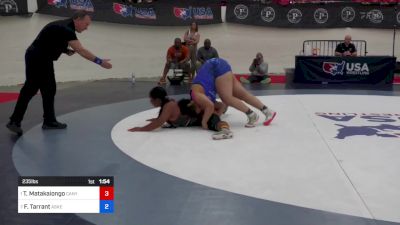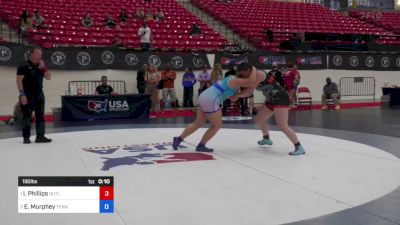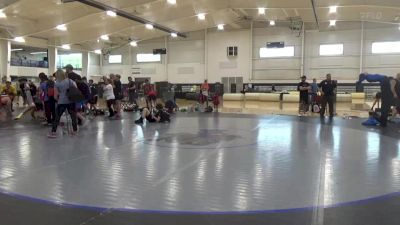NCAA Women's Wrestling Faces Dilemma Prior To Sanctioned Status
NCAA Women's Wrestling Faces Dilemma Prior To Sanctioned Status
NCAA women's coaches are divided on a proposal that could significantly alter the course of the 2024-25 season.

It doesn’t get closer than a tie.
A survey was sent to all NCAA women’s college coaches asking if more than 10 wrestlers should be allowed to participate at regionals next season.
The results?
YES: 36
NO: 36
Note: Several coaches didn't vote.
The next question on the survey was not split. If you answered yes, what should the number of qualifiers be? The results were 63.9 percent for 12 or less and 36.1 (10) percent for 15 (26 votes).
A maximum of 15 wrestlers from each team can participate at regionals, which means a maximum of 15 can compete at the National Collegiate Women’s Wrestling Championships.
Women’s wrestling is projected to be an NCAA-sanctioned sport by 2026. The assumption is that each team will qualify a maximum of one wrestler per weight for the national championships (10 total).
The argument for switching to 10 is that powerhouse programs like Iowa, King, McKendree, and North Central can stockpile their line-ups. Quality wrestlers might go elsewhere if multiple wrestlers from the same team couldn’t qualify.
Other teams lose out on high-caliber wrestlers and qualification spots as they fight an uphill battle against top programs.
A Change Of Heart
North Central coach Joe Norton used to think that was the way to go, and he understands the arguments for moving to 10, but he’s swung completely the other way. His team won the 2023 National Collegiate Women’s Wrestling Championships with 15 All-Americans and finished second this year with 14.
“The recruiting part of sending 15 is over because we’d go to 10 in 2026,” Norton said. “This is the last year I can recruit by saying in 2025 we can bring 15. Once we’re NCAA-sanctioned next year, I can’t recruit under that model anymore because 2026 will presumably be 10.
“When you throw the recruiting argument out of it, which is the biggest argument for going to 10, it’s a no-brainer to bring 15 because we’re trying to draw eyes to women’s wrestling. We’re trying to make people women’s wrestling fans. We’re trying to make men’s wrestling fans into women’s wrestling fans.”
Norton points to Iowa’s Sterling Dias as a reason to maintain 15 qualifiers for next season. Dias was the 101-pound runner-up to teammate Emilie Gonzalez at nationals this year. Assuming that Gonzalez is still the starter next season, Dias would miss the post-season with a move to 10.
Sterling Dias has two options: sit on the bench or transfer.
“Sterling Dias doesn’t want to transfer,” Norton said. “She wants to be in that room because she wants to develop. She wants to be on that team with those coaches. So we’re going to take the second-best wrestler in the country and we’re going to put her on the bench? That takes a person who would have been in the blood round and puts them in the eighth-place spot. That’s the person our new fans will be watching instead of Sterling.
“Sterling is exciting. Sterling will make non-women’s wrestling fans into women’s wrestling fans more than that eighth-place girl from another school. We need our best girls wrestling because we’re trying to make new women’s wrestling fans.”
That also means a growing program will miss out on an All-American if each team is allowed 15 qualification spots this season.
NAIA vs NCAA
Moving from 15 to 10 will give NAIA programs a recruiting advantage. The NAIA created an invitational tournament in 2019 and hosted a sanctioned championship for the first time in 2023.
A maximum of 12 wrestlers can qualify for the NAIA Championships.
“(Indiana Tech) coach Paul Rademacher said you’d be smart to stick with 15 because I’ll use it against you,” Norton said. “He’s right. If you can’t recruit under the premise that you can still go to the tournament, he will — and I’ll lose a quality girl for that reason. They’ll have that advantage over us.”
That’s not a problem on the men’s side since Penn State (11 NCAA D1 titles over 13 seasons) isn’t recruiting against Grand View (12 NAIA titles over 13 seasons). The Nittany Lions are recruiting against Ohio State, Iowa, and Cornell.
The top girl in the country might consider NCAA programs like Iowa, King, McKendree, and North Central, but is also considering NAIA programs like Grand View, Life, Southern Oregon, and William Penn.
Anaya Falcon is an example. She just made a U20 World Team at 50 kilograms by knocking off a handful of the top NCAA women as a high schooler. Falcon committed to Life University next season — an NAIA program in Marietta, Georgia.
Running Eagles coach Ashley Flavin can recruit another wrestler at Falcon’s weight by telling her she can still make the team.
This will only fuel the ongoing competition between the NAIA and the NCAA.
It's a numbers game right now, and that could make the 2024-25 season of women’s college wrestling the most compelling to date.
Related Content
 Ben Askren's Final Show | FloWrestling Radio Live (Ep. 1,023)
Ben Askren's Final Show | FloWrestling Radio Live (Ep. 1,023)Apr 29, 2024
 Kylie Rule On Wartburg's Inaugural Season: 'We Grew Together'
Kylie Rule On Wartburg's Inaugural Season: 'We Grew Together'Apr 29, 2024
 285 lbs 3rd Place - Brian Welser, Summit Hill vs Kaleb Britting, Wernersville
285 lbs 3rd Place - Brian Welser, Summit Hill vs Kaleb Britting, WernersvilleApr 28, 2024
 235 lbs Final - Tilisa Matakaiongo, Canyon View Falcons vs Faith Tarrant, Askeo International Mat Club
235 lbs Final - Tilisa Matakaiongo, Canyon View Falcons vs Faith Tarrant, Askeo International Mat ClubApr 28, 2024
 190 lbs Final - Isabella Phillips, Outlaw Wresling Club vs Ella Murphey, Tennessee
190 lbs Final - Isabella Phillips, Outlaw Wresling Club vs Ella Murphey, TennesseeApr 28, 2024
 189 lbs 3rd Place - Trenten True, Remsen vs Hunter Lavigne, Spencer
189 lbs 3rd Place - Trenten True, Remsen vs Hunter Lavigne, SpencerApr 28, 2024
 285 lbs Final - Kevin Oswalt, Rebellion vs Rocky Files, Pit Crew
285 lbs Final - Kevin Oswalt, Rebellion vs Rocky Files, Pit CrewApr 28, 2024
 189 lbs 5th Place - William Shakir, Allentown vs Brad Renninger, Cressona
189 lbs 5th Place - William Shakir, Allentown vs Brad Renninger, CressonaApr 28, 2024
 285 lbs Final - Jase Fuller, Michigan Mayhem vs Michael Yerian, Team Gotcha
285 lbs Final - Jase Fuller, Michigan Mayhem vs Michael Yerian, Team GotchaApr 28, 2024